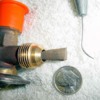quote:
Originally posted by LF - TP 2511:
Thanks, Scott.
As expected, what you received from Steve is a tube and fin style. That is the same unit I used.
A LOT of folks, sadly vendors included, somehow have gotten the wrong idea of what constitutes a "parallel flow" style.
Larry
Thanks for the replies and valuable discussion. –Very helpful.

The evaporator above looks like re-worked OE unit that borrows the position of one of the heater core coil stacks and uses it to increase the overall AC evaporator coil mass.
Does anyone know the evaporator coil mass of this or the stock OE unit? Alternatively, even just the overall L x W x H dimensions of the entire core would suffice in making a decent estimate for either unit. If anyone has that information a reply post would also be greatly appreciated.
The unit above and the OE unit appear to be slightly different in the configuration of the evaporator expansion circuit and this eBay unit below appears to be the same expansion circuit approach as the OE unit, except with the additional coil mass has been devoted to the evaporator similar the modified unit pictured above. It’s a big price for an evaporator/heater core.
http://www.ebay.com/itm/DeToma...em3ccbe71928&vxp=mtrThe following is just my take on the matter but with proper selection of the rest of the system components, I think sufficient performance can be achieved (at least that of the OE system) from R-134a, sticking with the OE evaporator, and utilizing a higher performing condenser in the much cooler greater airstream at the front of the car. I think the biggest challenge to the performance of the OE Pantera AC system design was the condenser sizing, location, and generally poor condenser fan performance. A better condenser and fan in the OE location would likely significantly improve the OE configuration performance for any refrigerant, but for a given coil mass you’ll never have the potential condenser performance that can be achieved in the front of the car, at least at speed, and probably under all conditions.
In my experience the overall OE Pantera system performance was adequate when it was at full charge (R12) and operating properly. So, I think the OE evaporator coil is
probably sufficient if the rest of the system is at least equal the performance of the OE system, which I think can be easily improved. With properly selected components and control scheme I don’t think R12 or R134a is material.
A couple other observations on the compressor sizing discussion earlier in the thread; all of the displacements referenced for the York, and Sandens are the swept volume or displacement per revolution. You can’t properly size the compressor without also considering the compressor operating speed.
The pulley diameter on my old York style recip compressor is about 6” while that on my Sanden 508 is 5”. The York pulley size was evidently selected for the 5 1/2” Pantera (but also std sbf size) crank pulley. So the original compressor was underdriven and concluding that 10.5 cubic inch compressor is required neglects the intended drive speed. Since changing the crank pulley diameter would change the drive speed and performance of everything else it’s driving, common practice is to size the driven pulleys for intended operating speed of the accessories.
It so happens that though an 8.5 cubic inch swept displacement Sanden 508 compressor is 20% less than the York’s, but with the Sanden OE pulley, it will operate at ~20% higher speed than the York and thus have comparable pumping displacement, assuming similar volumetric efficiency, for any given engine speed. I don’t think that’s a coincidence? So yes, you do need to run the Sanden faster but I would contend Sanden’s wobble plate piston compressors are designed to run faster and 20% faster than a York unit is certainly no stretch for them. As near as I can tell, virtually all Sanden wobble plate passenger car compressors come with this a 5” pulley. According to the Sanden manual, all Sanden wobble plate compressors are rated for continuous operation at 4000 RPM and many 6000 RPM. This is compressor speed not engine speed. With a 5.5” sbf crank pulley, a (Sanden) compressor with a 5” pulley will run ~10% slower than engine speed. I will never approach that continuous compressor operating speed and only see excursions to 7krpm or so and when doing so will not likely bring the AC along for that portion of the ride. I have a high speed cut out but usually just turn off the AC for spirited driving.
With a displacement of 155cc/9.5 in3, the Sanden SD7H15 is largest displacement passenger car compressor Sanden offers. Now I certainly note and agree with more cylinders means smoother pulses/operation, and slower operating speed means longer life, but in my view unless you were going to increase the drive pulley diameter to enjoy those benefits, I just can’t imagine why it would be needed in a Pantera. I’d contend the Pantera has more modest overall AC capacity needs than most passenger cars for the following reasons. First, being a two-seater, the passenger compartment in a Pantera is small compared to full size passenger car. It has much less volume and less window area which means less solar load, and at most two people to keep happy. It does have close passenger proximity to the engine compartment firewall, but front engine cars not only have an entire firewall they also typically have the additional heat load from undercar exhaust, transmission, and engine heat passing under the car. In a Pantera, if you insulate the firewall (I have done so) you’ve probably taken care of the majority of the addressable heat load. Next the floor (I just have the factory Jute) and then the doors (I have nothing). Though you could undoubtedly get improvement (both thermally and acoustically) with attention to the latter two, I think very satisfactory results can be achieved without further insulation beyond the firewall.
There are downsides to installing a larger pumping capacity compressor than needed. More capacity means more power to drive it and this can lug engine speed down at idle and cause erratic idle problems. In addition to understanding how the pulley and drive belt scheme affects compressor drive speed, when comparing AC systems and components from one vehicle to another, what will be engine idle and cruise speed. It’s not a trivial matter because the compressor speed is proportional to engine speed, and in almost all cases the biggest challenge to the cooling capacity of any AC system is with the engine at idle and car at rest….it’s the lowest engine speed (refrigerant compression/expansion/flow), lowest air flow across the condenser, and the highest effective ambient temperature due to parasitic short circuiting of cooling air with engine compartment and pavement heat.
In my case, I will pay some price in overall engine cooling capacity for having the condenser in front of the radiator but I have a Ron Davis radiator and it’s just a great piece work. The guy makes a great radiator. Even at twice the OE HP I think I’ll be just fine for my use. If I was running the Silver State and at max power for prolonged periods I may take pause installing the condenser in front of the radiator……but, I’m not. It’s just a street car or it wouldn’t even have AC. -I’ll let you all know how it turns out.
On the subject of relative refrigerant performance and efficiency, here is succinct summary by a notable manufacturer and I’ve found it to be consistent with all the other technical sources. Pay particular attention to sections 1a-d, but especially 1d.
http://www.tecumseh.com/~/medi...ization-of-R134a.pdfAnother useful document for technical information regarding Sanden Compressors:
http://www.sanden.com/objects/...Service%20Manual.pdfBTW Aus Ford, I really like your use of that SD508 as an onboard air compressor……very clever…..good on ya.
Best,
K









